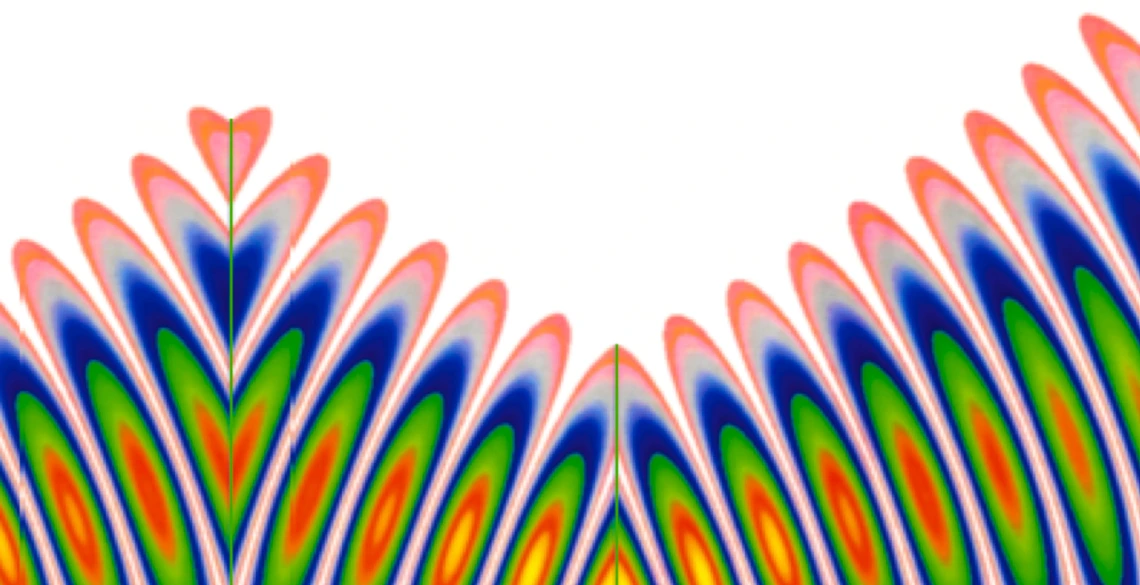What Nature Cannot Provide, Engineers Invent
Metamaterials pioneer Rick Ziolkowski is designing new substances for acoustics, optics and electromagnetics.

A snapshot in time of one of the first finite difference time domain simulations of negative refraction. (Image: Cover of the author's book, Metamaterials: Physics and Engineering Explorations.
During the early 20th century, engineers and physicists focused on exploiting the properties of naturally occurring materials. In other words, their work accommodated materials’ properties.
Today, engineers and physicists have turned this research model on its head by creating new materials with properties that don’t occur in nature, essentially building materials to fit their design needs.
Metamaterials are one new class of synthetic materials that are creating excitement in electromagnetics and acoustics.
Going Beyond
The name comes from a workshop sponsored by the Defense Advanced Research Projects Agency, or DARPA, in November 1999, with “meta” meaning “beyond.”
Professor Richard Ziolkowski, of UA Electrical and Computer Engineering, was one of the participants at that workshop, and he has been at the leading edge of metamaterials research since then, particularly in the area of electrically small antennas. In 2006, he and Nader Engheta, of the University of Pennsylvania, wrote a best-selling book on the subject, Metamaterials: Physics and Engineering Explorations.
Ziolkowski and his research team started out by modeling the basic physics of metamaterials and then began using those materials to create antennas. “Now we’ve transitioned into more applications for antennas,” he said. “For example, we’re creating systems with multiple antennas that have small electrical size. So we can work on multiple frequencies in a very small volume.”
Immediate applications include antenna systems for unmanned air vehicles and antennas that could be part of tiny GPS devices sewn into clothing or molded into helmets, allowing military, police or firefighters to know the exact locations of all the members in their units.
Antennas made with naturally occurring materials generally need to be larger than a quarter wavelength to be efficient and provide adequate bandwidth for many communications needs. In fact, physically small, highly efficient antennas that also exhibit wide bandwidth have been something of a holy grail in the communications community for years. But the basic physics of materials, in particular their positive refractive index, has stymied efforts to achieve these goals.
Refractive index accounts for the way visible light bends when it travels from one material to another. Differences in refractive index are what makes a straight straw look bent when it’s half submerged in a glass of water.
Many metamaterials exhibit double-negative properties, giving them a negative index of refraction, which allows them to focus light and other electromagnetic waves to a point much smaller than their wavelength. Turn this around and electromagnetic waves (such as microwaves and other radio waves) can be efficiently transmitted from an antenna that’s much smaller than their wavelength.
Ziolkowski has been working on a DARPA‑funded project with Boeing to create an extremely small, low-loss unit cell that has both negative electrical and negative magnetic qualities. Lots of unit cells can be combined to create a bulk material.
Artificial Ingredients
Metamaterials are made by embedding inclusions of one material into the host material, Ziolkowski explained. The inclusions are generally some type of metal.
“You try to make the equivalent of an artificial atom or artificial molecule that can have the electrical behavior or the magnetic behavior you’re seeking,” he said. “So it’s kind of like making electric dipoles or magnetic dipoles.” An electric dipole (two poles) includes one positive and one negative charge. A magnetic dipole acts as though it was created by two magnetic poles, one positive and one negative.
Ziolkowski and his research team have created a unit cell with low-loss properties that is only 1/75th of a wavelength at 400 MHz. One wavelength at this frequency is about three-quarters of a meter long or about 2.5 feet. An efficient quarter-wavelength antenna made from conventional materials would be about 8 inches long. An antenna made from material composed of the unit cells Ziolkowski created would be only about a third of an inch long.
Ziolkowski has been working on metamaterials and antennas in a frequency range from around 100 MHz up to 10 GHz so far. Boeing has already built a 100 MHz antenna based on his design, which is currently being tested by the National Institute of Standards and Technology.
Vision of Things to Come
Ziolkowski also has been exploring the optical regime, and has calculated that electrically small lasers could be designed using metamaterials. In one application, these tiny lasers could be used to help detect materials that are fluorescing, and might eventually be used in medical imaging.
“We’re also hoping to move our designs up into the terahertz range,” Ziolkowski added. “We’re exploring whether or not some of the metamaterial‑inspired antennas we’ve developed could move into the millimeter and terahertz range to be used for power harvesting.” This might involve beaming millimeter-wave power from one site to another, capturing it and converting it to direct current, the same type of electricity that comes from batteries.
“We’d also like to move up in frequency eventually into the solar range and create a highly efficient solar energy convertor,” he added.
“We have demonstrated that we can make efficient, electrically small antennas,” Ziolkowski said. “Now we’ve made predictions that we also can potentially create those electrically small antennas with a wide frequency bandwidth.”
That would break through a barrier that’s existed since the 1880s, when Heinrich Hertz transmitted his first radio signals, and would shrink communications systems to sizes that seemed like science fiction only a few years ago.

